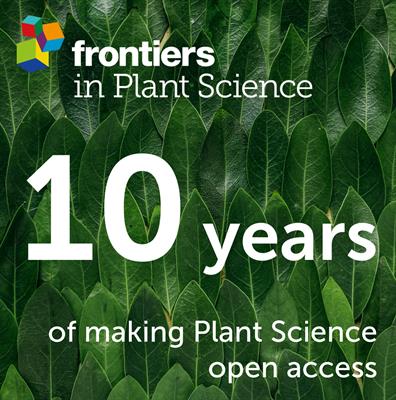Exogenous gibberellin suppressed taproot secondary thickening by inhibiting the formation and maintenance of vascular cambium in radish (Raphanus sativus L.)
IF 4.1
2区 生物学
Q1 PLANT SCIENCES
引用次数: 0
Abstract
IntroductionThe thickening of radish taproots is primarily determined by secondary growth driven by the vascular cambium and is a highly intricate process regulated by plant hormones, transcription factors, and many metabolic pathways. Gibberellin (GA), a plant hormone associated with cell elongation, is essential in secondary growth. However, the mechanism through which exogenous GA3 regulates secondary taproot growth in radishes remains unclear.MethodsIntegrated morphological, anatomical, hormonal, and transcriptomic analyses of taproots in radishes treated with GA3 and its biosynthesis inhibitor paclobutrazol (PBZ) were performed to explore their effects on taproot secondary growth and key regulatory pathways.ResultsGA3 significantly hindered taproot thickening by inhibiting the formation and maintenance of the vascular cambium, and PBZ promoted root development by increasing root length rather than root diameter. Transcriptome analysis revealed 2,014, 948, and 1,831 differentially expressed genes identified from the control vs. GA3, control vs. PBZ, and GA3 vs. PBZ comparisons, respectively. Kyoto Encyclopedia of Genes and Genome pathway enrichment analysis revealed that differentially expressed genes were primarily involved in the biosyntheses of secondary metabolites and metabolic pathways. GA3 significantly increased the levels of endogenous indole-acetic acid and the expression of auxin synthesis and signal transduction genes.DiscussionExogenous GA3 significantly inhibited the expression of genes involved in the maintenance and differentiation of vascular cambium, including WOX14, ER/ERL1, and XCP2. Exogenous GA3 affects root thickening in radishes primarily by regulating hormone signal transduction pathways, vascular cambium activity, and substance and energy metabolisms. Our findings provide insights into the mechanisms underlying taproot thickening in radishes and provide a valuable gene database for future studies.外源赤霉素通过抑制萝卜(Raphanus sativus L.)维管束形成和维持抑制直根次生增粗
引言萝卜直根的增粗主要是由维管束韧皮部驱动的次生生长决定的,是一个高度复杂的过程,受植物激素、转录因子和许多代谢途径的调控。赤霉素(GA)是一种与细胞伸长有关的植物激素,在次生生长中至关重要。方法对使用 GA3 及其生物合成抑制剂 paclobutrazol(PBZ)处理的萝卜直根进行形态学、解剖学、激素和转录组学综合分析,以探讨它们对萝卜直根次生生长和关键调控途径的影响。结果 GA3 通过抑制维管束形成和维持,明显阻碍了直根的增粗,而 PBZ 则通过增加根的长度而不是根的直径来促进根的发育。转录组分析显示,在对照与 GA3、对照与 PBZ 和 GA3 与 PBZ 的比较中,分别发现了 2,014 个、948 个和 1,831 个差异表达基因。京都基因和基因组百科全书》途径富集分析表明,差异表达基因主要参与次生代谢产物的生物合成和代谢途径。讨论外源 GA3 明显抑制了 WOX14、ER/ERL1 和 XCP2 等参与维管束壁的维持和分化的基因的表达。外源 GA3 主要通过调节激素信号转导途径、维管束韧皮部活性以及物质和能量代谢来影响萝卜根的增粗。我们的研究结果深入揭示了萝卜直根增粗的内在机制,并为今后的研究提供了一个宝贵的基因数据库。
本文章由计算机程序翻译,如有差异,请以英文原文为准。
求助全文
约1分钟内获得全文
求助全文
来源期刊

Frontiers in Plant Science
PLANT SCIENCES-
CiteScore
7.30
自引率
14.30%
发文量
4844
审稿时长
14 weeks
期刊介绍:
In an ever changing world, plant science is of the utmost importance for securing the future well-being of humankind. Plants provide oxygen, food, feed, fibers, and building materials. In addition, they are a diverse source of industrial and pharmaceutical chemicals. Plants are centrally important to the health of ecosystems, and their understanding is critical for learning how to manage and maintain a sustainable biosphere. Plant science is extremely interdisciplinary, reaching from agricultural science to paleobotany, and molecular physiology to ecology. It uses the latest developments in computer science, optics, molecular biology and genomics to address challenges in model systems, agricultural crops, and ecosystems. Plant science research inquires into the form, function, development, diversity, reproduction, evolution and uses of both higher and lower plants and their interactions with other organisms throughout the biosphere. Frontiers in Plant Science welcomes outstanding contributions in any field of plant science from basic to applied research, from organismal to molecular studies, from single plant analysis to studies of populations and whole ecosystems, and from molecular to biophysical to computational approaches.
Frontiers in Plant Science publishes articles on the most outstanding discoveries across a wide research spectrum of Plant Science. The mission of Frontiers in Plant Science is to bring all relevant Plant Science areas together on a single platform.
 求助内容:
求助内容: 应助结果提醒方式:
应助结果提醒方式:


